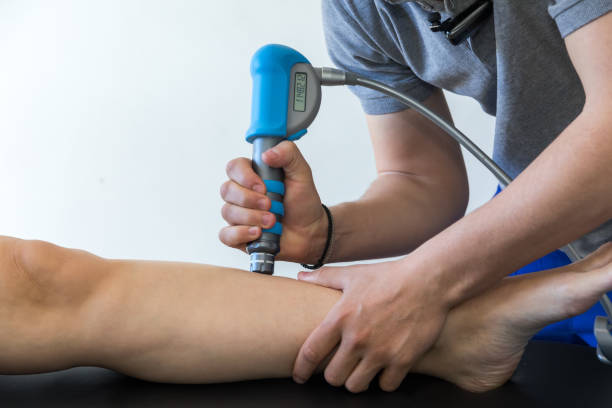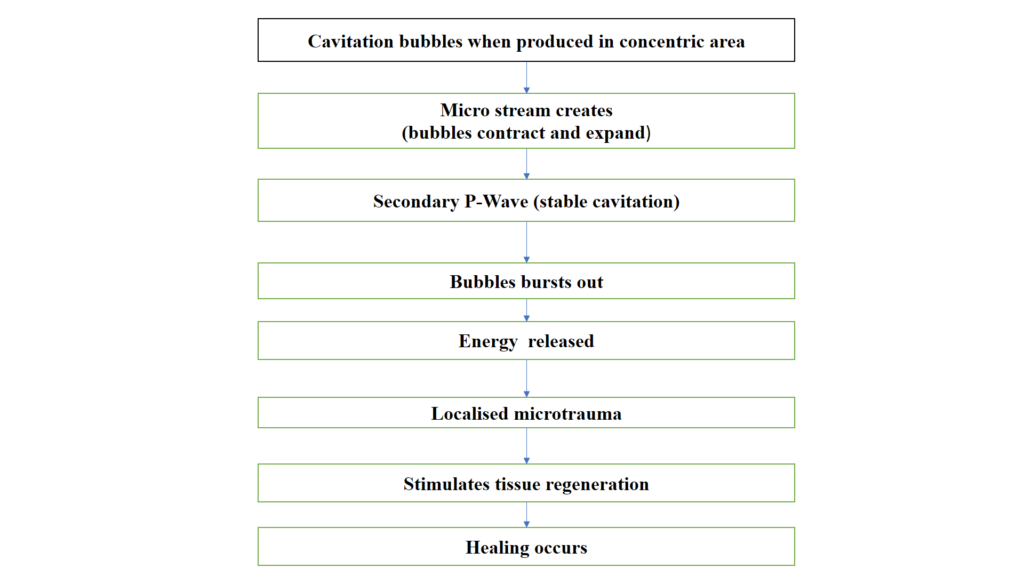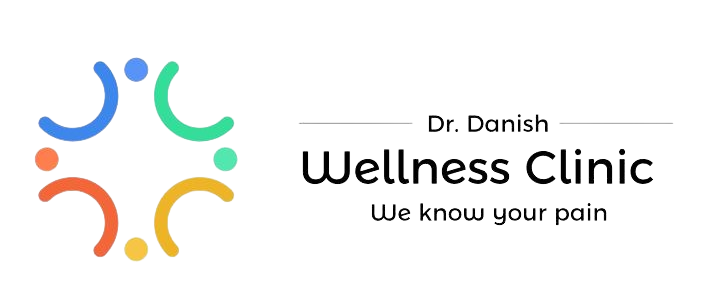Shock Wave Therapy RPW 2
History of Extracorporeal Shockwave Therapy
Extracorporeal Shockwave Therapy (ESWT) otherwise referred to as shockwave therapy, was first introduced into clinical practice in 1982 for the management of urologic conditions. The success of this technology for the treatment of urinary stones quickly made it a first-line, noninvasive, and effective method. Subsequently, ESWT was studied in orthopedics where it was identified that it could loosen the cement in total hip arthroplasty revisions[3]. Further, animal studies conducted in the 1980s revealed that ESWT could augment the bone-cement interface, enhance osteogenic response and improve fracture healing. While shockwave therapy has been shown to be beneficial in fracture healing, most orthopedic research has focused on upper and lower extremity tendinopathies, fasciopathies, and soft tissue conditions.
Physiology of ESWT
Shockwaves are sound waves that have specific physical characteristics, including nonlinearity, high peak pressure followed by low tensile amplitude, short rise time, and short duration (10 ms). They have a single pulse, a wide frequency range (0-20 MHz), and a high pressure amplitude (0-120 MPa)
These characteristics produce a positive and negative phase of shockwave. The positive phase produces direct mechanical forces, whereas the negative phase generates cavitation and gas bubbles that subsequently implode at high speeds, generating a second wave of shockwaves.
In comparison to ultrasound waves, the shockwave peak pressure is approximately 1000 times greater than the peak pressure of an ultrasound wave.
RPW 2
Technique
The Intelect Mobile 2 RPW is a powerful, yet portable radial pressure wave device. It features a lightweight and compact design as well as a quiet built-in compressor. The simple, ergonomically laid out controls enable all the key parameters to be easily changed. A clear, illuminated LED display removes ambiguity when monitoring pressure, frequency and number of pulses. Pulses can be initiated via a trigger mechanism on the handpiece. The Mobile 2 RPW is suitable for portable use as it is compact and light enough to be easily carried anywhere. Use it in the clinic or on the sports field. Standard accessories include the applicator set, beam transmitter, D-Actor 20mm transmitter, 250ml conductor transmission gel, CD user manual, power cord and revision kit.
Radial Pressure Wave Therapy (RPWT)-

Have you tried everything to treat your painful condition, but to no avail? If so, Radial Pressure Wave Therapy may be for you. This form of treatment has been proven successful in treating many conditions which are difficult to treat. This is typically the last conservative gift before surgery is recommended – so before undergoing the knife, take a chance with this therapy.
Contact us today to learn more!
What exactly is RPWT-
This Therapy uses therapeutic shockwaves to reduce pain and promote healing within the affected area(s) of the body. This form of treatment works to “lead to faster and long-term healing and regeneration of the tissue.”
Radial pressure wave (RPW) therapy uses ultrasound technology to treat bone and soft tissue injuries. Also known as shockwave therapy, RPW therapy sends high-energy acoustic (sound) waves into the treatment area to help reduce muscle pain and aches and promote healing without surgery or medication.

In the last two decades, shockwave therapy has increasingly been used for treating musculoskeletal disorders. The wave hits the body at skin surface and travels to a depth of around 2”, where it creates oscillations – repetitive back-and-forth movements – in the tissue. This stimulates blood supply and cell growth in the damaged area, leading to the regeneration of healthy tissue and bone.
Parts of RPWT-
It combines 2 techniques-
- Vibration therapy- The V-ACTOR is a vibration therapy handpiece and used as an accessory for radial pressure wave therapy. muscle vibration at a frequency of up to 50hz is improving the microcirculation enhancing the supply of nutriments and return of metabolic waste through the smallest vascular and lymphatic channels.
INDICATIONS:
- Treatment of superficial trigger points
- Lymphatic drainage
- Increase in local blood circulation
- Muscle smoothing along muscle bundles
- Connective tissue activation
- Wellness massage


2)Radial Pressure Wave – The shock waves or Radial pressure waves are generated with a precision ballistic mechanism in the handpiece. A projectile is accelerated by compresses air.
The motion and weight of the projectile produce kinetic energy. When the projectile impacts against an immovable surface, the shock transmitter, this kinetic energy is converted into sound energy. This acoustic pulse is transmitted into the tissue to be treated directly with the help of a gel.

For treatment purpose we mainly use 3 heads: –
Head name | frequency | intensity |
D-20 | o-50mm | 0.45mj/mm2 |
Ro-40 | 0-35mm | 0.48mj/mm2 |
DI-15 | 0-50mm | 0.63mj/mm2 |
Mechanism of RPWT:
Based upon the mechanism of stable cavitation.it occurs during a tensile phase of shock wave where negative pressure at room temperature creates a gas bubble.

Benefits of Radial Pressure Wave Therapy-
Benefits of Radial Pressure Wave Therapy-
Doctors first used shockwave therapy in the 1990s, to treat kidney stones. They observed that the treatment seemed to accelerate healing in both bone and soft tissues, which led to research into other medical applications of RPW treatments.
- Short treatment time (15-30minutes)
- Alternative to medication
- Results in a few treatments (4-6 sessions)
- Treat large areas
- Muscle massage with a vibrating applicator
- Non-invasive and no known significant adverse effects
Effects of Radial Pressure Wave Therapy-
Research over the past 20 years shows how RPW shockwave therapy is effective against chronic pain and inflammation.
- Improved blood flow: The acoustic waves in Shockwave therapy create microscopic tears in tissues, which causes the body to create new blood vessels. This increases blood flow and oxygenation to the treatment area, promoting faster healing.
- Reduces inflammation: Chronic inflammation causes pain and reduced function. Mast cells help fight inflammation; acoustic waves increase mast cell activity.
- Increased collagen production: Collagen is vital to bone and joint health as it is a key component in the structure of muscle, skin, and connective tissues. Shockwave therapy causes your body to increase collagen production, creating a strong support structure for new cells.
- Reduces calcification: Damaged tendons typically have a build-up of calcium. Acoustic waves break through that calcium build-up, which the body then expels naturally.
- Interrupts the “pain train”: Your body sends pain messages via a neurotransmitter called Substance P. Shockwave therapy lowers Substance P concentrations, interrupting those pain messages. That reduced concentration also inhibits your body’s inflammatory response to provide even more pain relief.
- Relaxes trigger points: Extreme muscle tension in the back, neck, shoulders, and limbs (your body’s pain trigger points) impedes blood flow to those areas. This causes pain as the muscle no longer receives enough oxygen. Blood flow is also how your body removes waste. Lack of oxygen and waste build-up causes even more tension in the muscle, creating a cycle known as metabolic crisis. Acoustic wave therapy releases the tension in these trigger points, easing pain and breaking the cycle.
Conditions Treatable with Radial pressure wave Therapy-
The shockwave will radiate into the affected area and spread to the surrounding areas nearby. Relief should be noticed almost immediately, as pain is alleviated through the shockwaves.
This form of treatment accounts for a quick recovery with quick results – in fact, there are usually no more than 3-4 sessions required for optimum results.

- Shoulder Pain: Calcification, chronic inflammation, or acute injury may cause shoulder pain and limited function. Most patients experience a significant reduction in symptoms within four treatments.
Hip Pain: Muscles and tendons in your hips often suffer from overuse, particularly as you age. RPW reduces inflammation, speeds healing, and eliminates pain.
Knee osteoarthritis: Patients who have this difficult-to-treat condition typically feel pain relief immediately following the first treatment.
- Tennis Elbow- steroid injections and pain medications neither offer a permanent solution. In addition, pain medications are highly addictive and should be avoided whenever possible. Shockwave therapy offers permanent pain relief in only a few sessions.
Plantar Fasciitis: Plantar fascia connects the heel bone to the rest of your foot. When it becomes inflamed or injured, heel pain results. RPW relaxes the plantar fascia, promoting healing and alleviating heel pain.
Plantar Fasciitis: Plantar fascia connects the heel bone to the rest of your foot. When it becomes inflamed or injured, heel pain results. RPW relaxes the plantar fascia, promoting healing and alleviating heel pain.
Chronic tendinopathy-Overuse and acute injury may cause chronic inflammation of the tendon (known as tendinopathy). Patients usually experience symptom relief within three to five treatments.
Medial tibial stress syndrome: Repetitive stress to the shin area, typically due to walking or running on hard or uneven surfaces, often causes pain and inflammation. Shockwave therapy gets you back on your feet twice as quickly as possible. Medial tibial stress syndrome-Repetitive stress to the shin area, typically due to walking or running on hard or uneven surfaces, often causes pain and inflammation. Shockwave therapy gets you back on your feet twice as quickly as possible.
- Cervicalgia
- Dorsalgia
- Lumbalgia
- Myofascial trigger points
- Frozen shoulder
- Tendinitis
- Shin splints
- Achilles tendinopathy
- Calcaneal apophysitis
- De Quervain’s tenosynovitis
- Osgood-Schlatter disease
- Golfer’s elbow
- And more
Contraindications of Radial pressure wave therapy-
Treatment with the device is not permitted in the following cases:
- Coagulation disorders (hemophilia)
- Use of anticoagulants, especially macular
- Thrombosis
- Tumor diseases, carcinoma patients
- Pregnancy
- Children in growth
- Cortisone therapy up to 6 weeks after injection
Dosage: –
it is important to begin treatment at a low energy value, before gradually increasing to the maximum level that the patient can tolerate. The current ‘optimal’ protocol across all conditions appears to be 2,000 shocks applied once a week at the maximum tolerable intensity.

Potential side effects of RPW therapy
It is important that the patient understands that, following RPW therapy, minor side effects may occur, usually within 1-2 days of the initial treatment. These include:
- Reddening skin – the cardinal signs of inflammation, which the therapy is intended to promote
- Swelling
- Pain
- Hematoma
- Petechiae – the appearance of small red dots on the skin. This can be substantially reduced by applying plenty of water-based transmission gel to the area before you begin treating it, as radial pressure waves travel better through water.
- Skin lesions – may occur following a previous cortisone therapy
These side effects generally abate within 5-10 days, but treatment should not be repeated until they have diminished.
General guidelines and tips
- Once you’ve localized the painful areas you plan to treat, it can be helpful to mark these with a felt pen.
- Some applicators can be heavy to hold, so it’s important to find a comfortable grip that can be maintained for the duration of the treatment.
- Make sure to apply a generous amount of transmission gel to the skin overlying the treatment area, as this will help the pressure waves propagate into the tissue.
- While application techniques are dictated by indication, small circular movements can be used to treat the most painful spots.
- During tendon treatment, it can be beneficial to keep the tendon in a slight stretch.
- Perform post-treatment assessments to see if there is a decrease in pain, and better function.
If you’re looking for non-surgical, drug-free relief from your pain, schedule an appointment with us today. We’re dedicated to helping patients achieve total body health and wellness. That’s why we work with you to resolve the issue that’s causing your pain, not simply hide it with medication.
